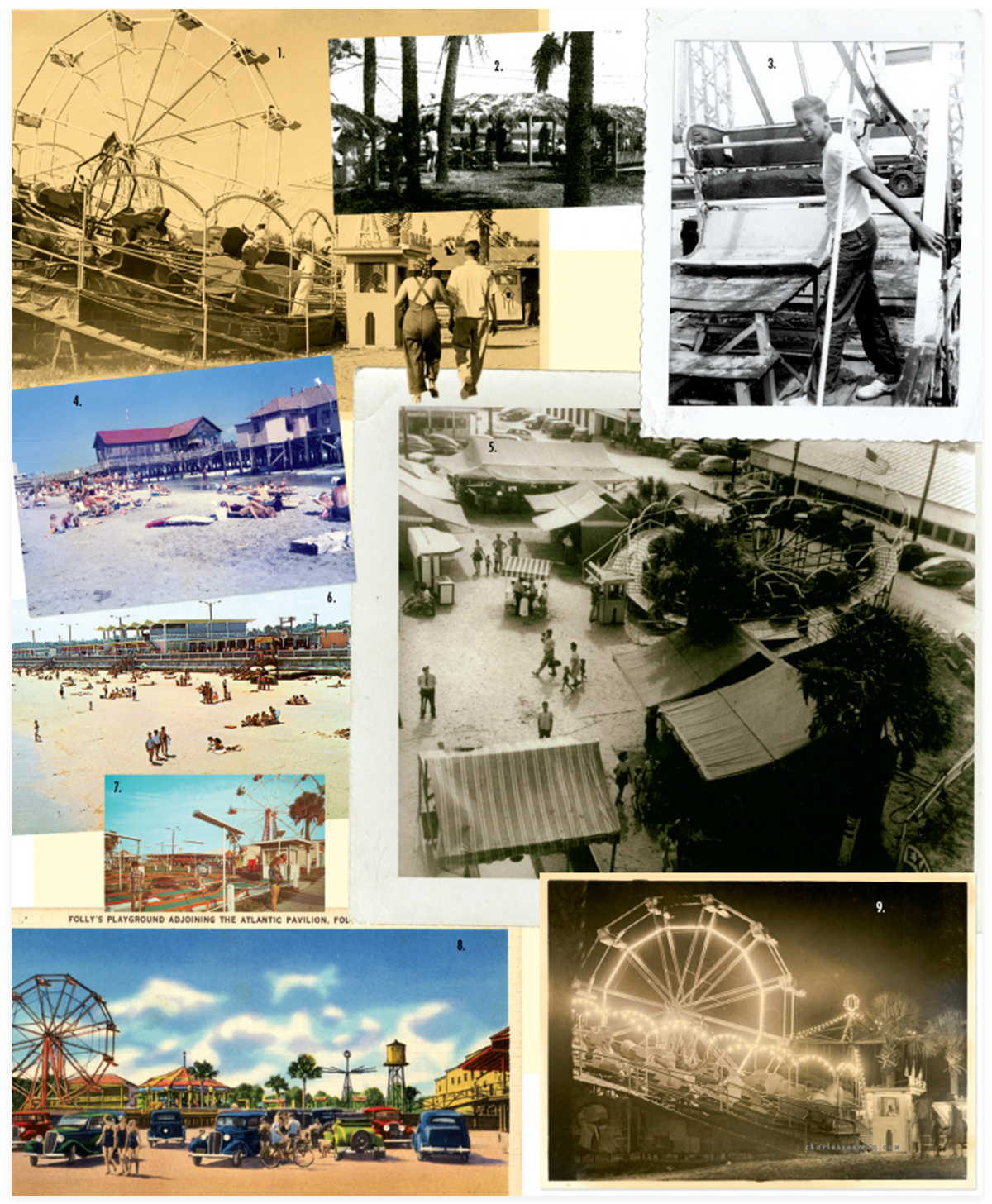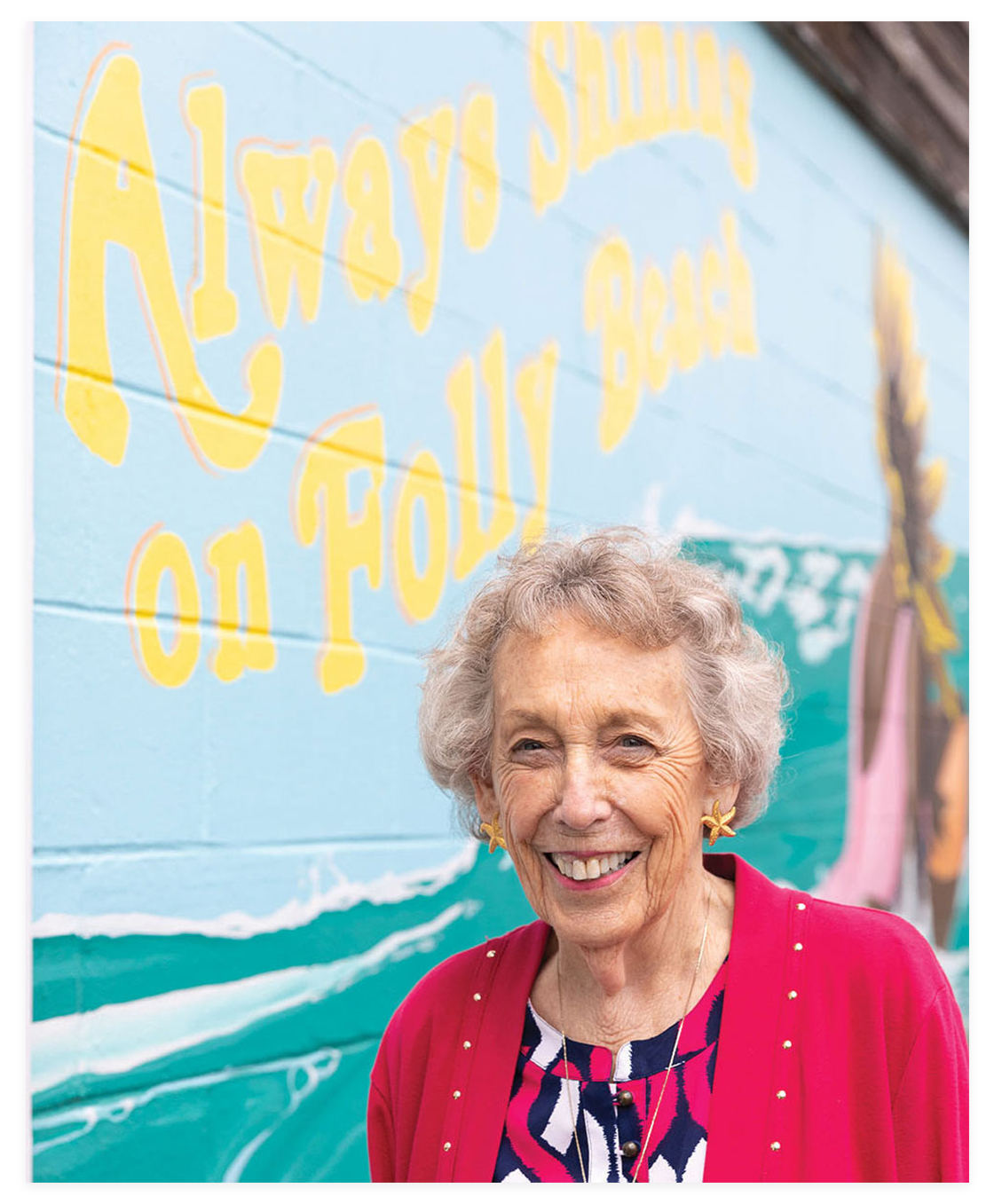
1. The Ferris wheel and Tilt-a-Whirl at the pavilion amusement park, circa 1950 (courtesy of The Charleston Museum); 2. The thatch-roofed Rainbow Corner dancing pavilion, circa 1950s (courtesy of Robert Knight); 3. Robert Knight working the Ferris wheel in 1956 (courtesy of Robert Knight); 4. The Atlantic House Restaurant in 1988, the year before it was destroyed by Hurricane Hugo (courtesy of Jimmy Creech); 5. The Tilt-a-Whirl and other amusements, circa 1950 (courtesy of Robert Knight); 6. The Ocean Plaza, circa 1960 (courtesy of Robert Knight); 7. A early 1960s postcard of the miniature golf course and other amusements at the Ocean Plaza (courtesy of Bill Bryan); 8. A postcard from the 1940s of the pavilion, falsely stating Folly’s distance from Charleston as 10 miles (courtesy of The Charleston Museum); 9. At night in the 1950s, the rides were awash with white lights (courtesy of The Charleston Museum).
Carnival rides and roadhouses, the beach was where the fun began
Between the pavilion and the pier stood a small amusement park, about a block long. It had a sign that read: “Welcome to Folly’s Playground.” Crammed into this space were a merry-go-round, a Ferris wheel, swings, a popular ride called “the Whip,” and perhaps another ride or two. There was a small wooden refreshment stand that sold standard beach fare, including ice cream cones and sodas.
To a child, though, it was magic. From high atop the Ferris wheel, the beach spread out before you. A wooden boardwalk connected Center Street to the pier in front of the amusement park, just a spot of sand wedged between the street and the Atlantic Ocean.
Most of Folly’s major attractions were jammed along Center Street and adjoining streets for several blocks. A bowling alley was across the street from the carnival. Center Street was lined with eateries and bars, but the carnival was the spot for children of all ages. It was set up every year at the beginning of beach season and was pulled down after Labor Day.
To the left and the right of Center Street for several blocks stretched an array of beachside cottages, eateries, and rustic bars. Many seaside bars staggered from the pier. Their names changed over the years, but they all dispensed beer in copious quantities. At one time, the nearest bar to the pier was the Seaside Grill. It was one of the wilder spots with outdoor decks and pool tables inside. It had the most colorful clientele of all the bars.

Next to the Ocean Front Hotel was an area known as Rainbow Corner. It was a cluster of colorful buildings nestled in a grove of palmettos right on the ocean. There was an area for dancing and drinking. It was one of the most popular spots on the front beach. In September 1959, Hurricane Gracie battered Rainbow Corner, and the entire complex was demolished to make way for the massive and ambitious Ocean Plaza development of 1960. The old ramshackle hotel also bit the dust as part of the blocks-long development that radically changed the look and flavor of Folly.
Two structures that escaped the developer’s eye were a couple of old, abandoned beach houses a short distance from the former Rainbow Corner. They were joined in the 1970s to create what came to be called the Atlantic House and OTO (Over the Ocean) Bar. The hurricane of 1940 had done excessive damage to these grand dames. But they withstood Gracie in 1959 and David in 1979, only to be destroyed 10 years later by Hugo.
Local Legend: “I love it,” says longtime Folly resident, city clerk, and defacto island historian Marlene Estridge, who moved with her family from Barnwell when she was nine years old, learned how to drive on the beach, and worked for every mayor the island’s ever had. While Estridge acknowledges that Folly has changed drastically of late, she says it’s still a “tight-knit community” and would prefer that new people “live with us and not just rent weekly.” In March, some 200 people gathered at Folly Beach Baptist Church’s fellowship hall to celebrate her 90th birthday and sing “It’s Marlene,” a tune penned by late singer-songwriter Rick Huff about the island stalwart.